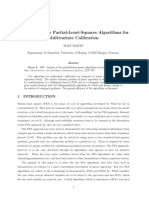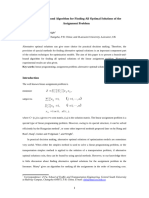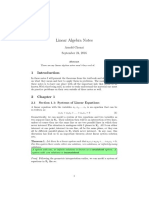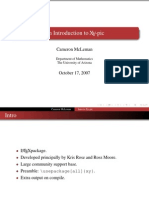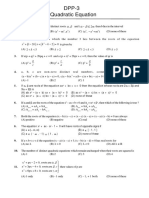Basic Theorem of Linear Programming
Basic Theorem of Linear Programming
Uploaded by
Mithun HaridasCopyright:
Available Formats
Basic Theorem of Linear Programming
Basic Theorem of Linear Programming
Uploaded by
Mithun HaridasOriginal Title
Copyright
Available Formats
Share this document
Did you find this document useful?
Is this content inappropriate?
Copyright:
Available Formats
Basic Theorem of Linear Programming
Basic Theorem of Linear Programming
Uploaded by
Mithun HaridasCopyright:
Available Formats
BASIC THEOREM OF LINEAR PROGRAMMING:
Consider the linear program (T):
minimize c
x
subject to
Ax = b
x 0 ,
where A is an mn matrix of rank m.
Recall the following denitions:
Denition 1.1 A feasible solution is an element x R
n
which satises the constraints
Ax = b, and x 0.
Among all solutions of the equation Ax = b, certain ones are called basic.
Denition 1.2 Let B be any m m non-singular submatrix of A consisting of linearly
independent columns of A. Then if the n m components of a solution x corresponding
to the columns of A which do not appear in B are set equal to zero, the solution, x
B
, of
the resulting set of equations is said to be a basic feasible solution with respect to the
basis consisting of columns of B. The components of x
B
associated with the columns of
B are called the basic are called basic variables.
Note that the equation Ax = b may not have any basic solutions in the general case.
In order to insure that basic solutions exist, it is usual to make certain assumptions: (a)
that n > m; (b) that the rows of A are linearly independent; (c) that the rank of A is m.
These conditions are sucient for the existence of at least one basic solution.
It may well occur that some components of a basic solution are zero.
Denition 1.3 If one or more basic variables in a basic solution has the value zero, then
that solution is said to be a degenerate basic solution.
We shall refer to a feasible solution which is also basic as a basic feasible solution.
A feasible solution that achieves the minimum value of the cost functional is said to be
1
an optimal feasible solution. If it is also basic, then it is an optimal basic feasible
solution.
Let us return to the linear programming problem T. The fundamental result is that we
need only search among the basic feasible solutions for an optimal solution. Indeed, that
is what the Simplex Method actually does.
Theorem 1.4 (The Fundamental Theorem of Linear Programming)
Given the linear programming problem T, where A is an mn matrix of rank m:
1. If there is any feasible solution, then there is a basic feasible solution.
2. If there is any optimal solution, then there is a basic optimal solution.
Proof: Suppose that a feasible solution exists. Choose any feasible solution among
those with the fewest non-zero components. If there are no non-zero components, then
x = 0 and x is a basic solution by denition. Otherwise, take the index set J :=
j
1
, j
2
, . . . , j
r
with elements corresponding to those x
j
i
> 0. Then if we denote the
corresponding columns by a
(j
1
)
, a
(j
2
)
, . . . a
(jr)
there are two possibilities:
1. The set of columns is linearly independent. In this case, we certainly have r m. If
r = m the corresponding solution is basic and the proof is complete. If r < m then,
since A has rank m, we choose mr vectores from the remaining nr columns of A
so that the resulting set of m column vectors is linearly independent. Assigning the
value zero to the corresponding mr variables yields a (degenerate) basic feasible
solution.
2. The set of columns a
(j
1
)
, a
(j
2
)
, . . . a
(jr)
is linearly dependent. Then there is a
choice of scalars
j
i
, not all zero, such that
j
1
a
(j
1
)
+
j
2
a
(j
2
)
+ . . . +
jr
a
(jr)
= 0. (1.1)
Without loss of generality, we may take
j
1
,= 0 and, indeed,
j
1
> 0 (otherwise
multiply (1.1) by 1).
Now, since x
j
i
> 0, the corresponding feasible solution x
J
is just a linear combina-
tion of the columns a
(j
i
)
. Hence
Ax =
r
i=1
x
j
i
a
(j
i
)
= b.
2
Now multiplying the dependence relation (1.1) by a real number and subtracting,
we have
A(x ) =
r
i=1
(x
j
i
j
i
) a
(j
i
)
= b,
and this equation holds for every although one or more components, x
k
j
k
may violate the non-negativity condition. Now let = (
1
, . . . ,
n
)
where
k
:=
j
i
, k = j
i
0, k ,= j
i
Then, for each value of the vector x is a solution of the constraint equations.
Note that, for the special value = 0, this vector is the original feasible solution.
Now, as increases from 0, the components of x will individually change;
each will either increase, decrease, or stay constant, depending on whether the
corresponding
i
is positive, negative, or zero.
Suppose, for some i
o
,
io
0. Then (x
io
io
) 0 for all > 0. On the other
hand, if for some i
o
,
io
> 0, then (x
io
io
) remains greater than 0 only for
suciently small > 0. Now, we take
:= min
x
i
x
i
> 0,
i
> 0
. (1.2)
Then
corresponds to the rst value of for which one or more non-zero components
of x becomes 0. For this value of the vector x
is feasible and has at
most r 1 positive components. Repeating this process if necessary, we can obtain
a feasible solution with non-zero components corresponding to linearly independent
columns. In this situation, the previous alternative applies.
This completes the proof of the rst part of the theorem.
Now assume that x
is an optimal solution. There is no guarantee that this optimal
solution is unique. In fact, we have seen cases where there is no uniqueness. Some of these
solutions may have more positive components than others. Without loss of generality, we
assume that x
has a minimal number of positive components. If x
= 0 then x
is basic
and the cost is zero. If x
,= 0 and if J is the corresponding index set, then there are
3
two cases as before. The proof of the rst case in which the corresponding columns are
linearly independent is exactly as in the previous proof of this case.
In the second case, we proceed just as with the second case above. To do this, however,
we must show that, for any , the vector x
is optimal. To show this, we note that
the associated cost is
c, x
) = c, x
) c, )
Then, for suciently small [[, the vector x
is a feasible solution for positive or
negative values of . Hence, we conclude that
c, ) = 0
since, were it not, then we could determine a small of the proper sign, to make
c, x
) < c, x
) ,
which would violate the assumption of the optimality of x
.
Having established that the new feasible solution with fewer positive components is also
optimal, the remainder of the proof may be completed exactly as in case 2 above. 2
REMARK: If we are dealing with a problem in n variables and m constraints, we can
produce an upper bound for the number of basic feasible solutions. Specically, we must
choose m columns from a set of n columns and there are at most
n
m
=
n!
m! (n m)!
,
ways to make the selection. Of course, some choices may not lead to a linearly independent
set of m columns so that this number is an upper bound.
4
You might also like
- Analysis of Two Partial-least-Squares Algorithms For Multivariate Calibration PDFDocument17 pagesAnalysis of Two Partial-least-Squares Algorithms For Multivariate Calibration PDFAna RebeloNo ratings yet
- 1 - 10 Mean Median ModeDocument2 pages1 - 10 Mean Median Modecristina gomezNo ratings yet
- IB Prob Distribution QuestionsDocument4 pagesIB Prob Distribution QuestionsjleodennisNo ratings yet
- Lecture 2Document10 pagesLecture 2kostas_ntougias5453No ratings yet
- MIT15 093J F09 Rec02Document3 pagesMIT15 093J F09 Rec02santiago gonzalezNo ratings yet
- First-Order Equations: 1.1 The Simplest ExampleDocument19 pagesFirst-Order Equations: 1.1 The Simplest Examplecheenu15No ratings yet
- Chech How To Include That Graph Abranch-And-boundDocument7 pagesChech How To Include That Graph Abranch-And-boundjairos shinzehNo ratings yet
- 4 Iterative Methods: 4.1 What A Two Year Old Child Can DoDocument15 pages4 Iterative Methods: 4.1 What A Two Year Old Child Can DoNicky WarburtonNo ratings yet
- Simplex Method For Solving Linear Programming Problems With Fuzzy NumbersDocument5 pagesSimplex Method For Solving Linear Programming Problems With Fuzzy NumbersRosalin MalarNo ratings yet
- Class_notes_on_Linear_Programming_SimpleDocument19 pagesClass_notes_on_Linear_Programming_Simplesohail khanNo ratings yet
- Solutions of First Order Linear SystemsDocument6 pagesSolutions of First Order Linear SystemsbittibssiNo ratings yet
- Lecture 5Document6 pagesLecture 5Tony AbhishekNo ratings yet
- Camacho2007 PDFDocument24 pagesCamacho2007 PDFFabianOmarValdiviaPurizacaNo ratings yet
- S10 Prodigies PPTDocument33 pagesS10 Prodigies PPTKrish GuptaNo ratings yet
- 5 Solutions of Linear ProgramsDocument4 pages5 Solutions of Linear ProgramsHillal TOUATINo ratings yet
- Notes 3: From Geometry To Simplex Method: IND E 513Document23 pagesNotes 3: From Geometry To Simplex Method: IND E 513Tushar GuptaNo ratings yet
- Math PrimerDocument13 pagesMath Primertejas.s.mathaiNo ratings yet
- Additional Theory For Module 4: Dynamic Analysis: Eigensolution ExampleDocument7 pagesAdditional Theory For Module 4: Dynamic Analysis: Eigensolution ExamplephysicsnewblolNo ratings yet
- Chapter Two Algebra - 122247Document14 pagesChapter Two Algebra - 122247GetnetNo ratings yet
- Ch8 PDFDocument47 pagesCh8 PDF王大洋No ratings yet
- CombOptim_Ch3Document36 pagesCombOptim_Ch3Trần Minh KiệtNo ratings yet
- An IntroductionDocument46 pagesAn Introductionharshalpareta148No ratings yet
- Algebraic Methods in Combinatorics: 1 Linear Algebra ReviewDocument5 pagesAlgebraic Methods in Combinatorics: 1 Linear Algebra ReviewPurbayan ChakrabortyNo ratings yet
- Opt1 16Document7 pagesOpt1 16Venkatesh NagarajuNo ratings yet
- LIN1 SolvedDocument5 pagesLIN1 SolvedSheeraz AhmedNo ratings yet
- Penalty Decomposition Methods For L - Norm MinimizationDocument26 pagesPenalty Decomposition Methods For L - Norm MinimizationLing PiNo ratings yet
- Algebraic Combinatorics - Po-Shen-Loh - MOP 2011Document5 pagesAlgebraic Combinatorics - Po-Shen-Loh - MOP 2011David DavidNo ratings yet
- Systems of Differential EccuationsDocument16 pagesSystems of Differential EccuationsRaulNo ratings yet
- Sparse RegressionDocument37 pagesSparse Regressionchthonic LuciferNo ratings yet
- Linear Algebra and Matrix Theory: Part 4 - Eigenvalues and EigenvectorsDocument8 pagesLinear Algebra and Matrix Theory: Part 4 - Eigenvalues and EigenvectorscrazynupNo ratings yet
- Linear Algebra Notes PDFDocument3 pagesLinear Algebra Notes PDFJOhnNo ratings yet
- Types of Solution SetDocument3 pagesTypes of Solution SetJaymar Talledo BalihonNo ratings yet
- 22 3 Repted Eignval Sym MatxDocument16 pages22 3 Repted Eignval Sym MatxDaniel SolhNo ratings yet
- 5 2rrDocument12 pages5 2rrJuan Sebastian Ramirez AyalaNo ratings yet
- Further Mathematical Methods (Linear Algebra) 2002 Solutions For Problem Sheet 4Document10 pagesFurther Mathematical Methods (Linear Algebra) 2002 Solutions For Problem Sheet 4Gag PafNo ratings yet
- Lecture 5Document13 pagesLecture 5kostas_ntougias5453No ratings yet
- I. Introduction To Convex Optimization: Georgia Tech ECE 8823a Notes by J. Romberg. Last Updated 13:32, January 11, 2017Document20 pagesI. Introduction To Convex Optimization: Georgia Tech ECE 8823a Notes by J. Romberg. Last Updated 13:32, January 11, 2017zeldaikNo ratings yet
- Algebra 1Document10 pagesAlgebra 1Humza ShaikhNo ratings yet
- 1704 08490Document18 pages1704 08490kipling905No ratings yet
- m40 s12 Lecture4Document3 pagesm40 s12 Lecture4ammar_harbNo ratings yet
- Orf523 S24 HW1Document5 pagesOrf523 S24 HW1Marius ConstantinNo ratings yet
- Chapter 3-The Simplex Method, IDocument3 pagesChapter 3-The Simplex Method, Iayush1313No ratings yet
- Lecture 6: May 9: 1.1 Simplex AlgorithmDocument5 pagesLecture 6: May 9: 1.1 Simplex AlgorithmHillal TOUATINo ratings yet
- CJR Aljabar LinearDocument11 pagesCJR Aljabar LinearAnonymous 8cT9HsebytNo ratings yet
- Theorist's Toolkit Lecture 2-3: LP DualityDocument9 pagesTheorist's Toolkit Lecture 2-3: LP DualityJeremyKunNo ratings yet
- Math 201 Lecture 23: Power Series Method For Equations With Poly-Nomial CoefficientsDocument5 pagesMath 201 Lecture 23: Power Series Method For Equations With Poly-Nomial CoefficientsTanNguyễnNo ratings yet
- CanonicalDocument7 pagesCanonicalsumitmishraNo ratings yet
- GMM Estimation PDFDocument35 pagesGMM Estimation PDFdamian camargoNo ratings yet
- Factor AnalysisDocument57 pagesFactor AnalysisRajendra KumarNo ratings yet
- Sreenath Vemula's Answer To What Must Be My Strategy To Score Full Marks in The GATE Mathematics (Also Suggest Best Book For Practicing Prev. Year's Questions) - QuoraDocument8 pagesSreenath Vemula's Answer To What Must Be My Strategy To Score Full Marks in The GATE Mathematics (Also Suggest Best Book For Practicing Prev. Year's Questions) - QuoraChitransh PandeyNo ratings yet
- Assignment 11 Answers Math 130 Linear AlgebraDocument3 pagesAssignment 11 Answers Math 130 Linear AlgebraCody SageNo ratings yet
- Eigenvalues of GraphsDocument29 pagesEigenvalues of GraphsDenise ParksNo ratings yet
- A Problem in Enumerating Extreme PointsDocument9 pagesA Problem in Enumerating Extreme PointsNasrin DorrehNo ratings yet
- ODE Finite Element MethodDocument36 pagesODE Finite Element Methodeng.ahmedhassanomarNo ratings yet
- Benders DecompositionDocument20 pagesBenders DecompositionVamsi PatwariNo ratings yet
- Ch05 NotesDocument6 pagesCh05 NotesKaneNo ratings yet
- algebra CHAPTER TWO and THREE (1)Document17 pagesalgebra CHAPTER TWO and THREE (1)yerosanabrahimNo ratings yet
- Least Squares Solution and Pseudo-Inverse: Bghiggins/Ucdavis/Ech256/Jan - 2012Document12 pagesLeast Squares Solution and Pseudo-Inverse: Bghiggins/Ucdavis/Ech256/Jan - 2012Anonymous J1scGXwkKDNo ratings yet
- Advanced Linear Programming OrganisationDocument7 pagesAdvanced Linear Programming Organisationtequesta95No ratings yet
- Non-Linear Dynamics Homework Solutions Week 4: Strogatz PortionDocument4 pagesNon-Linear Dynamics Homework Solutions Week 4: Strogatz PortionVivekNo ratings yet
- Basic Matrix TheoremsDocument3 pagesBasic Matrix Theoremsamoako22003No ratings yet
- Ordinary Differential Equations and Stability Theory: An IntroductionFrom EverandOrdinary Differential Equations and Stability Theory: An IntroductionNo ratings yet
- MFD S Assignment 2Document18 pagesMFD S Assignment 2safiyaNo ratings yet
- Ass1 PDFDocument2 pagesAss1 PDFOsho GeraNo ratings yet
- Exp-Function Method For Nonlinear Wave Equations: Ji-Huan He, Xu-Hong WuDocument9 pagesExp-Function Method For Nonlinear Wave Equations: Ji-Huan He, Xu-Hong Wufalcon_vamNo ratings yet
- Answer All Questions.: Sulit 3472/1Document16 pagesAnswer All Questions.: Sulit 3472/1azirawaniNo ratings yet
- Digital Signal Processing Tutorial PDFDocument102 pagesDigital Signal Processing Tutorial PDFkandikatlavarsha2002No ratings yet
- Tacoma BridgeDocument9 pagesTacoma BridgejgravisNo ratings yet
- Lecture 2 - Description (00-12-01)Document50 pagesLecture 2 - Description (00-12-01)MahdiNo ratings yet
- XypicDocument27 pagesXypicmarkusribeirogielerNo ratings yet
- Electricity and Magnetism NotesDocument170 pagesElectricity and Magnetism NotesUmit UtkuNo ratings yet
- EEE 3105: Signals and Linear Systems: Cross Correlation FunctionDocument8 pagesEEE 3105: Signals and Linear Systems: Cross Correlation FunctionMozammel HossainNo ratings yet
- CHAPTER 3: Cyclic and Convolution CodesDocument30 pagesCHAPTER 3: Cyclic and Convolution CodesHamzah NaserNo ratings yet
- Pdf&rendition 1Document6 pagesPdf&rendition 1Priyanka ChauhanNo ratings yet
- 2k20 T.Y.B.com. Com. Sys. and App. 05Document1 page2k20 T.Y.B.com. Com. Sys. and App. 05shrinath_chauhanNo ratings yet
- BasicCalQ3W1 SLMDocument16 pagesBasicCalQ3W1 SLMNasos 2No ratings yet
- DPP-3 Quadratic Equation - OmgDocument6 pagesDPP-3 Quadratic Equation - OmgSumit RajNo ratings yet
- Discovery Activity of FunctionsDocument3 pagesDiscovery Activity of Functionsapi-437363879No ratings yet
- Euler Bernoulli PDFDocument2 pagesEuler Bernoulli PDFJoshuaNo ratings yet
- Feda' Abdel Aziz Mustafa SalamehDocument126 pagesFeda' Abdel Aziz Mustafa SalamehFizzerNo ratings yet
- Special Cases:: - Unbounded Solution: - Multiple OptimalDocument38 pagesSpecial Cases:: - Unbounded Solution: - Multiple OptimalAffu ShaikNo ratings yet
- Mathematics: IntegrationDocument9 pagesMathematics: Integrationameen jayahNo ratings yet
- Open Boundary Example in FEMMDocument5 pagesOpen Boundary Example in FEMMKULDEEP THAKURNo ratings yet
- SG 113 65475f2949f801.65475f2ace9015.87061823Document6 pagesSG 113 65475f2949f801.65475f2ace9015.87061823zjyblksNo ratings yet
- First Steps in Vibration Analysis Using ANSYSDocument6 pagesFirst Steps in Vibration Analysis Using ANSYSsyndicate_mauliNo ratings yet
- Find Each Indicated Product: 2s (S - 4) (X + 9) (X - 2) (3 - 5m)Document12 pagesFind Each Indicated Product: 2s (S - 4) (X + 9) (X - 2) (3 - 5m)Maida Castillejo DoniegoNo ratings yet
- Kami Export - James Holloman - 8-6 ADocument1 pageKami Export - James Holloman - 8-6 AJames HollomanNo ratings yet
- Unit 7: Trigonometric Functions: Graphing The Trigonometric FunctionDocument55 pagesUnit 7: Trigonometric Functions: Graphing The Trigonometric FunctionNoli NogaNo ratings yet
- Transformations Concept MapDocument1 pageTransformations Concept Maphemof44839No ratings yet
- MCMC Methods For Fitting and Comparing Multinomial Response ModelsDocument28 pagesMCMC Methods For Fitting and Comparing Multinomial Response ModelsPhilippe AurierNo ratings yet
